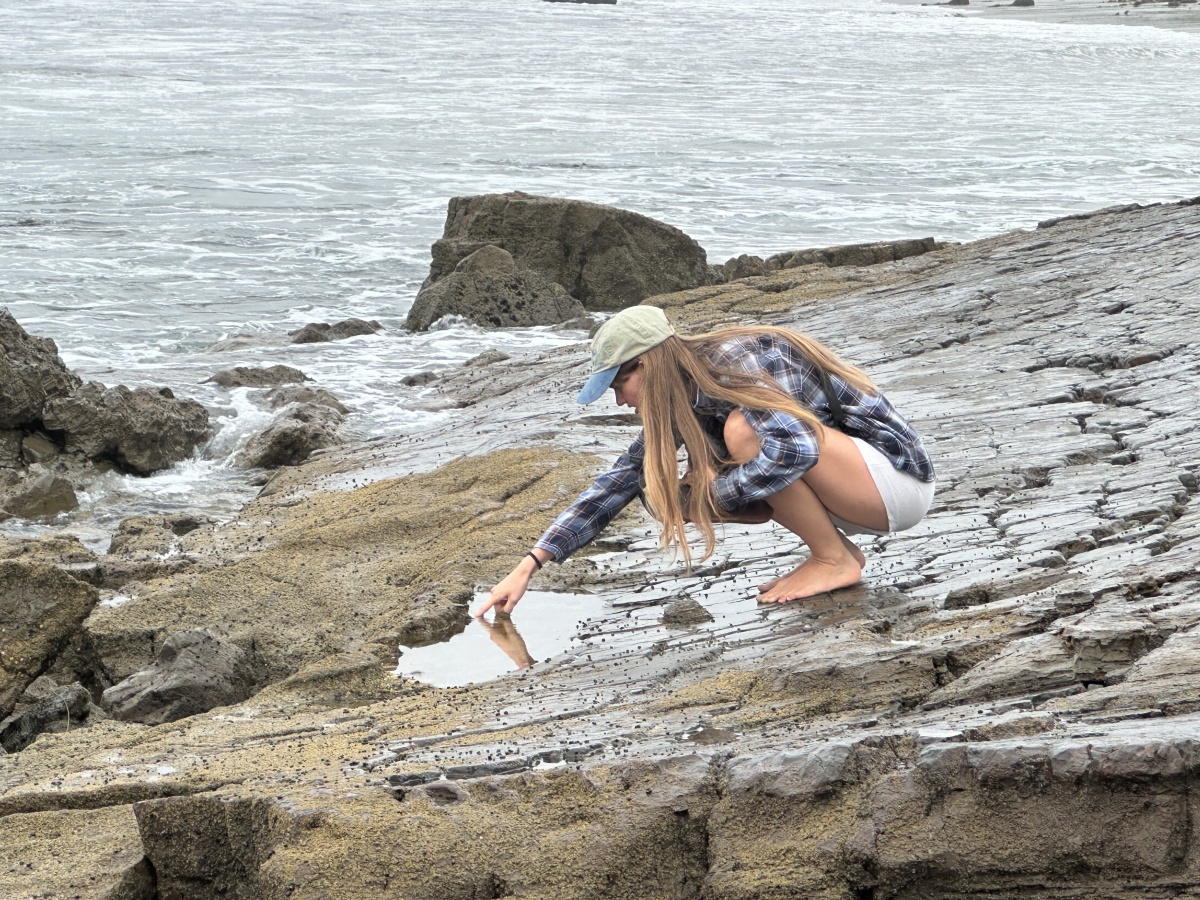Tide Pooling Log: Birthday Nature Walk along the Beach

On the morning of my birthday late this summer, I wanted to go to the beach– of course! The tide was somewhere between 1 and 2 feet, so I didn’t expect to do much tide pooling, if any of the rocks would evening be exposed at this location in SoCal. Despite this, I thought we could take a long walk, have lunch at our favorite beachside restaurant, and observe some nature along the way. But the intertidal life wasn’t deterred by the poor low tide, and we saw several groups of remarkable animals.
Parking on the bluffs, we made our way down the winding cliff trail to the sand and immediately started seeing birds. Birds are one of the least noticed intertidal animal groups, perhaps because most tidepoolers are more interested in the invertebrate life. But birds are a vital part of the intertidal ecosystem as predators and scavengers, so they are worth noting, even if you aren’t into birding.

We, however, are into birding and took our time with these animals. Of course, the gulls of many kinds were abundant, but several other species were as well. This beach was quite narrow and backed up to wilderness area bluffs, likely making this area more appealing to these less common species than wide open, frequently trafficked beaches.


The first large group was of black turnstones (Arenaria melanocephala) in the sandpiper family (formerly in the plover family). About 30 or 40 of them were foraging among the drying seaweed and on the small rock outcroppings that were exposed. Although occasionally seen inland, this bird mostly lives near the shores and feeds on mollusks, crustaceans, and insects during the breeding season. The bulk of the population nests in Alaska and winters along the California coast. Perhaps these individuals were already here for the winter.

We also saw a couple of black-bellied plovers (Pluvialis squatarola), also migratory birds that breed in the Arctic and have non-breeding populations in most coastlines of the world. Unlike the turnstones, these plovers are sand foragers, avoiding the rocks and eating small mollusks and crustaceans. There were only a few here in their gray non-breeding plumage; they do have black bellies while breeding. They are listed as vulnerable on the IUCN red list.


There were also several whimbrels (Numenius phaeopus), some of my favorite wading birds for their elegant form, beautiful and distinctive eyestripe and ethereal-sounding name. Another migratory bird, their long beaks reach deep into the sand and long legs allow them to wade deeper into the water than the turnstones and plovers. They have a short, repetitive call, but this one was yawning! And then decided to take a little nap.


As we moved past the sandy section, we came to where the bedrock reached the cliff and created long, high intertidal pools. Although there wasn’t anything particularly unusual in these pools, they were unusual in themselves, being so high in the intertidal. I had recently gotten some close-focus binoculars to use tide pooling, allowing me to spot smaller animals and sit back from a comfortable position while looking.

I spied several clumps of tiny glass anemones, possibly in the Genus Diadumene, dotting the tide pools along with hundreds of hermit crabs in dozens of varieties of shells. Although numbering in the millions, these blueband hermits (Pagurus samuelis) are essential to intertidal function as the clean-up crew, eating all kinds of organic matter.


Farther up on the dry rocks were sea slaters in the Genus Ligia. Also known as sea cockroaches, these guys aren’t the subject of much interest among amateur tidepoolers. They inhabit the highest of intertidal zones and although they need moisture, they don’t venture into the water unless in dire situations, like being chased by a terrestrial predator.

After walking about a mile or so down the beach, we climbed the wooden stairs to the top of the cliff and had lunch. The tide was going out to about 1 foot, and I knew our walk back had better chances of seeing lower intertidal life on some of the rock outcroppings scattered among the sand.

Sure enough, much more of the rocks where we had seen the turnstones were exposed on our way back. As more people had arrived later in the day, the flock of turnstones had moved to rocks jutting out of the wave farther out, where they continued to forage. I joined several other beachgoers who were poking around one of the larger outcroppings.


The first animals that caught my attention were the anemones. Large swaths of aggregating anemones (Anthopleura elegantissima) low on the sides of the rock were closing their tentacles as the waves retreated, but the lowest animals were still extended, collecting food from the water. No matter how many times I see large colonies of these animals, they’re still endlessly beautiful. There were also several smaller colonies, one of which had some of the brightest pink tips I had ever seen in aggregating anemones.


Stepping past the outer boulders, I encountered several sunburst anemones (Anthopleura sola) settled in the sand, also with unique colors. One boasted the same shade of pink tentacles as the colony; another had brilliant, dark purple tips. I have never before or since seen an individual with such coloration.

The waves were swashing at my feet when I saw the last and perhaps most fun observation of the day. While the water was up to my ankles, an oblong shape emerged from the sand and half swam, half scuttled along until the water started to recede. With a few swift motions of its claws, only the top of its carapace could be seen. Rock crabs!.. On the sand? Apparently. There were six or seven of these crabs, with anywhere from three to five-inch carapaces, that emerged to feed when underwater and buried themselves when exposed to air. They didn’t at all seem to mind my feet in their sandy homes and continued their swimming and burying ritual as I twisted about to get photos while trying not to step on them. Most of the animals were yellow rock crabs (Metacarcinus Anthonyi), which often have brown or purple-ish carapaces (makes sense, I know) with yellow-tinged legs. I believe there was one Pacific rock crab (Romaleon antennarium) among them, but it was hard to be sure.


I spent a bit of time with the crabs, watching their repeated behavior and especially enjoying seeing them all emerge when the waves came in. Soon enough, it was time to trek back up the bluffs to the car. Even without expecting it and with a substandard low tide, the intertidal life here did not disappoint.

#Birthday #Nature #Walk #Beach #Tide



